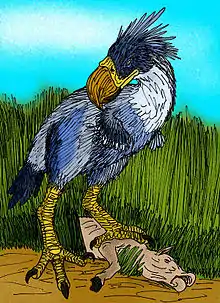Brontornis
Brontornis is an extinct genus of either anseriforms or giant flightless terror birds (Phorusrhacidae) that inhabited Argentina during the Early to Middle Miocene.[1] Certainly the heaviest of the Phorusrhacidae family, and the birds from the Americas as a whole, it is one of the largest birds that has ever existed.[2]
| Brontornis | |
|---|---|
 | |
| Fossil femur | |
 | |
| Fossil tarsometatarsus | |
| Scientific classification | |
| Kingdom: | Animalia |
| Phylum: | Chordata |
| Class: | Aves |
| Order: | Cariamiformes |
| Family: | †Phorusrhacidae |
| Subfamily: | †Brontornithinae |
| Genus: | †Brontornis Moreno & Mercerat 1891 |
| Type species | |
| †Brontornis burmeisteri Moreno & Mercerat 1891 | |
| Synonyms | |
|
Genus synonymy
Species synonymy
| |
Description

Brontornis had an estimated height of 2.8 m (9 ft 2 in) and its body mass is estimated between 350 and 400 kg (770 and 880 lb), making it the heaviest terror bird but slightly behind Kelenken in height and skull length. It may have been about 1.75 m (5 ft 9 in) tall at the back. These measures would make Brontornis the fifth-heaviest bird found thus far, after Vorombe titan, Dromornis stirtoni, Aepyornis maximus, and Pachystruthio dmanisensis.[2]
A comparison of the tarsometatarsi of two B. burmeisteri specimens, FM-P13259 and MLP-91 (lectotype), both coming from the same geographical region and geological formation, shows them as not to present any anatomical differences, apart from size, where in the first is around one third smaller than the second. The idea is that they are examples of intraspecific variation, possibly sexual dimorphism. There is the possibility that they represent two species.[2]
Discovery

Fossils of the terror bird have been found in the Santa Cruz and Monte León Formations in Argentina.[3] It is known from bones, mainly of the legs and feet but also portions of some skulls and backbone, found in several localities of Santa Cruz Province. It coexisted with some slightly smaller and more active phorusrhacids like Phorusrhacos.
Classification
Recent work has cast doubt on the hypothesis that Brontornis is a phorusrhacid. Brontornis may actually represent an anseriform, with other genera traditionally assigned to Brontornithinae (Physornis and Paraphysornis) being true phorusrhacids. The subfamily containing the latter two had been proposed to be renamed to Physornithinae, with Physornis fortis as the type species. If these conclusions are valid, this would mean that there are three groups of giant basal anseriformes, in chronological order of divergence: the gastornithids (Gastornis and kin), Brontornis, and finally the mihirungs of Australia.[4][5]
However, other analyses have also argued that Brontornis exhibits thoracic vertebrae diagnostic of phorusrhacids, supporting its placement within that group.[6]
References
- Moreno & Mercerat, 1891
- Alvarenga & Höfling, 2003
- "Brontornis". Fossilworks. Retrieved 1 April 2020.
- Agnolin, 2007
- Buffetaut, 2014
- Alvarenga et al., 2011
Bibliography
- Buffetaut, É. 2014. Tertiary ground birds from Patagonia (Argentina) in the Tournouër collection of the Muséum National d'Histoire Naturelle, Paris. Bulletin de la Société Géologique de France 185. 207–214. Accessed 2020-04-01. doi:10.2113/gssgfbull.185.3.207
- Alvarenga, H.; L. Chiappe, and S. Bertelle. 2011. Living Dinosaurs: The Evolutionary History of Modern Birds, 187–208. Wiley. Accessed 2020-04-01. OCLC 664324132 ISBN 978-0-470-65666-2
- Agnolin, F. 2007. Brontornis burmeisteri Moreno & Mercerat, un Anseriformes (Aves) gigante del Mioceno Medio de Patagonia, Argentina. Revista del Museo Argentino de Ciencias Naturales 9. 15-25. Accessed 2020-04-01.
- Alvarenga, Herculano M.F., and Elizabeth Höfling. 2003. Systematic revision of the Phorusrhacidae (Aves: Ralliformes). Papéis Avulsos de Zoologia 43. 55-91. Accessed 2020-04-01.
- Moreno, Francisco P., and A. Mercerat. 1891. Catálogo de los pájaros fósiles de la República Argentina conservados en el Museo de La Plata, 7-71. 1; Anales del Museo de La Plata.
